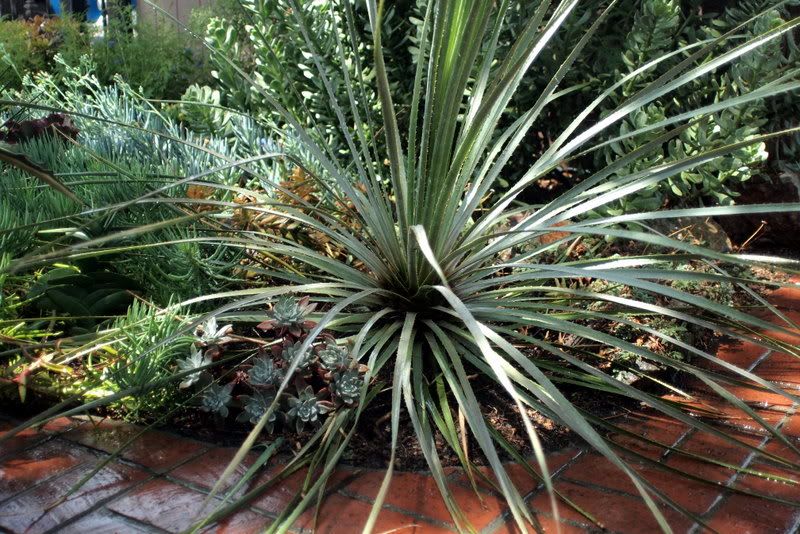I moved this fairly large dasylirion out of its 22-inch clay pot and into the ground. A job for long sleeves and heavy gloves, as well as alerting those in the house to be on standby for a possible shout for help in case I needed it. Turns out I did need the help and shouted and shouted for it. And then shouted some more. (Curse their Ipods and earplugs!) Only the corgi came running to my aid, bless his furry little hide.
The only way I’ve found to get a large, unwieldy plant out of a big, heavy pot is to get gravity on your side. Help finally did arrive (of the opposable thumb variety), and the two of us lifted the pot onto a porch. I tipped the pot on its side over the edge of the porch, and started working it out with a small shovel, teetering the pot over the edge, letting gravity join in. When the rootball was freed up, I eased it out of the pot, using the height of the porch to keep from damaging the leaves, and my assistant held the pot while I gently tugged the sotol out. The pot was pulled away, a trash can lid was moved in place, and the root ball lifted onto the trash can lid for transport to its new home. Trash can lids are invaluable for these kinds of tasks.
A dark-leaved coprosma, an evergreen New Zealand shrub, was growing too large for this spot and was sacrificed to make way for the sotol.
The dudleyas, the whitish succulents to the left, were also in the pot with the sotol, as was a small Agave potatorum that was stuck in as a pup at some forgotten time, and a big plant of Kalanchoe pumila, which has now been moved into its own pot. I’ve been wanting to take this large pot of very mature plants apart for a while, but the right moment (and nerve) never presented themselves.
I’m documenting this minor disturbance because the dasylirion rootball, despite taking special care, was still slightly manhandled in the move and may not survive the transfer from pot to garden, and mid-summer is not the optimal planting time anyway. But I’ve always subscribed to the when-the-mood-strikes planting timetable, and yesterday’s schedule was wide open, the weather still mild and overcast, and I at last found the nerve. It took a while to grow the dasylirion to this size, and it looks wonderful in its new home, a much improved see-through effect over the chunky coprosma, which was becoming a martyr to pruning to keep in bounds. The big greyish shrub behind it is Senecio amaniensis, an unnamed succulent I bought several years ago at the California Cactus Center for which I just recently got an ID. I had no idea the senecio would grow this large, 4X5 with light pruning, and the 6-foot tall coprosma was making life too difficult here for all concerned. Fingers crossed, and with careful watering (not too much), the sotol will survive the move.


I’m on the opposite coast, a cactus amateur and enjoy reading your blog. That is a beautiful plant, a gorgeous garden and I will be awaiting, with bated breath, the outcome of the dasylirion’s (which I’ve never heard of)move.
Sheri in SE Georgia
It is truly a beauty, that sotol! My prediction is that it will be very happy and healthy in it’s new place (which looks fabulous by the way). I have a couple D. wheeleri (none this large, unfortunately) which I’ve abused pretty bad and they’ve came through like super stars.
Thanks for stopping by, Sheri.
Loree, I hope you’re right!
I can’t even count the plants I have moved using meatball surgery techniques. Since it’s still de facto June , we may as well push the envelope.
I’m very interested in the Senecio amaniensis,which appears to be hardy in z9. So now all I have to do is find one !
Kathy, I’m starting you a cutting today.
Oh I hope it survives the move. It looks like it belongs in precisely that spot.
Beautiful silver compositions, Denise. My mouth is hanging open at the thought of a 6 foot coprosma and I think back to last year’s 12 inch “annual” I had that went the usual way of tropicals in my yard…. I will hope for the continued health of the sotol – it looks marvey there.
Megan, thanks for the good wishes!
Cindy, this coprosma just shot up in this spot. I’ve got others much slower growing.
I put my D. longissimum in the ground midsummer, and it was fine. The only way I could manage was to drop the pot into the hole, smash the pot, and pull out the pieces. Luckily it was an ugly pot. Your way sounds better.
A trash can lid handle-side-down on the can makes a decent temporary potting bench.
I love it…what a gorgeous specimen, hope it survives! I’m much the same way about doing things in the garden. I may know that it’s not the best time for planting, transplanting or starting a new bed, but sometimes i get a wild hare (as my dad would say) and just have to do it NOW…like you’ve said, when I finally get the nerve up.
Scott